ART’s corporate fund strategy pays off as FUM hits $260bn
With the completion of the Woolworths Group and Endeavour Group successor fund transfer (SFT), Australian Retirement Trust (ART) now manages around $260 billion for 2.3 million members. It’s the second largest SFT that ART has undertaken, adding around $4.3 billion and 25,000 new members into the fund, and it’s expected that other SFTs for Commonwealth Bank Group Super, AvSuper and Alcoa Super will complete this financial year.
“We have a very experienced inhouse transition team, allowing us to deliver a positive member experience during the transition and provide the employer with the opportunity to refresh their value offering for their employees,” said chief commercial officer Dave Woodall (pictured).
“Our offering is twofold in that it supports both employers and employees. Being member centric during a key moment – like transferring someone’s super account – is really important to instil confidence and engagement in the process… We’ve built infrastructure to support corporate Australia in reducing the time, effort and risk to deliver on their employee superannuation benefits via an employer platform that provides clearinghouse services and bespoke payroll administration.”
Back in March, Woodall told ISN that ART predecessor fund Sunsuper had embarked on a “very clear strategy” to build its capabilities in the corporate institutional segment around six years ago by leveraging its size to take on funds with members in more bespoke superannuation arrangements like defined benefit.
“We’re still using the enterprise wide processes for core admin tasks – contributions, benefit payments, that sort of stuff,” Woodall said. “But we sit on top of that this bespoke benefit design and that does create customised columns. We’re leveraging the mothership, if I can put it that way, by using our core registry and core systems.”
ART’s now a little over halfway to its goal of being a $500 billion fund by 2030, with other growth opportunities presenting in the small- to medium-size enterprise segment, direct digital channels and advice. That $500 billion goal is borne out of an understanding that superannuation is now a scale game and that if ART isn’t growing market share it’s “losing it to competitors”.
“Our focus is on ensuring we’ve got good retention and good growth. It’s critically important for us to maintain the 2.1 million members that we have – but in our humble opinion, that isn’t enough,” Woodall told ISN in March.
“($500 billion) is not an absolute number, but we have to be careful that we don’t go from the second largest to the third or fourth because we’ve taken our eye off the dynamics of a consolidating market. If we’re losing market share to Aussie or Aware, whoever it is, we’ll lose an opportunity for leveraging our scale.”










